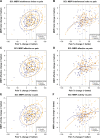Pain relief and functional improvement in patients with neuropathic pain associated with spinal cord injury: an exploratory analysis of pregabalin clinical trials
- PMID: 27366103
- PMCID: PMC4913987
- DOI: 10.2147/JPR.S97770
Pain relief and functional improvement in patients with neuropathic pain associated with spinal cord injury: an exploratory analysis of pregabalin clinical trials
Abstract
Background: Characterizing relationships between pain relief and function can inform patient management decisions. This analysis explored graphically the relationship between pain relief and functional improvement in patients with neuropathic pain associated with spinal cord injury in two clinical trials of pregabalin.
Methods: This was a post hoc analysis of two randomized, double-blind, clinical trials in patients who were treated with pregabalin (n=181) or placebo (n=172) for neuropathic pain associated with spinal cord injury. The bivariate relationship between percent pain relief and absolute change in the functional outcomes with placebo and pregabalin was evaluated graphically using scatter plots, and loess curves illustrated the extent of the relationship between pain and function. Linear trend analysis evaluated the statistical significance of these relationships using Initiative on Methods, Measurement, and Pain Assessment in Clinical Trials (IMMPACT)-based thresholds of pain reduction (<15%, 15% <30%, 30% to <50%, and ≥50%). Outcome measures included modified Brief Pain Inventory pain interference with function in one of the studies and the Medical Outcomes Study Sleep Scale (an 11-point Numeric Rating Scale) and the Hospital Anxiety and Depression Scale (HADS) for the pooled studies.
Results: Data ellipses showed a shift with pregabalin relative to placebo toward greater improvement with increasing pain relief for all outcome measures except HADS. Loess curves suggested a relationship between increased pain relief and improved function except for HADS, with the clearest relationship observed for sleep. Linear trend analysis showed significant relationships between pain and Medical Outcomes Study Sleep Scale (P<0.0001) and between pain and function on the modified Brief Pain Inventory Interference Index and most individual items (P<0.05).
Conclusion: Greater functional improvements were generally achieved at higher levels of clinically significant pain reduction. Pregabalin resulted in shifts from placebo toward greater functional improvement with greater pain relief.
Keywords: function; neuropathic pain; pregabalin; sleep; spinal cord injury.
Figures



Similar articles
-
Efficacy and tolerability of pregabalin using a flexible, optimized dose schedule in Korean patients with peripheral neuropathic pain: a 10-week, randomized, double-blind, placebo-controlled, multicenter study.Clin Ther. 2010 Dec;32(14):2370-85. doi: 10.1016/j.clinthera.2011.01.014. Clin Ther. 2010. PMID: 21353106 Clinical Trial.
-
Examining the Time to Therapeutic Effect of Pregabalin in Spinal Cord Injury Patients With Neuropathic Pain.Clin Ther. 2015 May 1;37(5):1081-90. doi: 10.1016/j.clinthera.2015.02.028. Epub 2015 Apr 4. Clin Ther. 2015. PMID: 25850879
-
Pregabalin for Neuropathic Pain: Why Benefits Could Be Expected for Multiple Pain Conditions.Clin Drug Investig. 2016 Nov;36(11):877-888. doi: 10.1007/s40261-016-0423-x. Clin Drug Investig. 2016. PMID: 27448285
-
Efficacy and Safety of Pregabalin in Neuropathic Pain Followed Spinal Cord Injury: A Review and Meta-Analysis of Randomized Controlled Trials.Clin J Pain. 2019 Mar;35(3):272-278. doi: 10.1097/AJP.0000000000000675. Clin J Pain. 2019. PMID: 30499836
-
Pregabalin: a novel gamma-aminobutyric acid analogue in the treatment of neuropathic pain, partial-onset seizures, and anxiety disorders.Clin Ther. 2007 Jan;29(1):26-48. doi: 10.1016/j.clinthera.2007.01.013. Clin Ther. 2007. PMID: 17379045 Review.
Cited by
-
Pregabalin in the reduction of pain and opioid consumption after burn injuries: A preliminary, randomized, double-blind, placebo-controlled study.Medicine (Baltimore). 2019 May;98(18):e15343. doi: 10.1097/MD.0000000000015343. Medicine (Baltimore). 2019. PMID: 31045775 Free PMC article. Clinical Trial.
-
Long-Term Efficacy of Carboxymethyl-Chitosan in Advanced Knee Osteoarthritis: A Twelve-Month Follow-Up Study on Non-Responders to Hyaluronic Acid.Biomedicines. 2025 Jan 22;13(2):270. doi: 10.3390/biomedicines13020270. Biomedicines. 2025. PMID: 40002684 Free PMC article.
-
Efficacy of prolotherapy in comparison to other therapies for chronic soft tissue injuries: A systematic review and network meta-analysis.PLoS One. 2021 May 26;16(5):e0252204. doi: 10.1371/journal.pone.0252204. eCollection 2021. PLoS One. 2021. PMID: 34038486 Free PMC article.
-
The analgesic effect of intravenous methylprednisolone on acute neuropathic pain with allodynia due to central cord syndrome: a retrospective study.J Pain Res. 2018 Jun 25;11:1231-1238. doi: 10.2147/JPR.S160463. eCollection 2018. J Pain Res. 2018. PMID: 29983586 Free PMC article.
-
A Silver Lining of Neuropathic Pain: Predicting Favorable Functional Outcome in Spinal Cord Injury.J Pain Res. 2023 Jul 27;16:2619-2632. doi: 10.2147/JPR.S414638. eCollection 2023. J Pain Res. 2023. PMID: 37533560 Free PMC article.
References
-
- Siddall P, Cousins M, Otte A, Griesing T, Chambers R, Murphy TK. Pregabalin in central neuropathic pain associated with spinal cord injury. A placebo-controlled trial. Neurology. 2006;67:1792–1800. - PubMed
-
- National Spinal Cord Injury Statistical Center [webpage on the Inter-net] Spinal Cord Injury. Facts and Figures at a Glance. 2013. [Accessed August 22, 2013]. Available from: https://www.nscisc.uab.edu/PublicDocuments/fact_figures_docs/Facts%20201....
-
- Widerstrom-Noga EG, Felipe-Cuervo E, Yezierski RP. Chronic pain after spinal injury: interference with sleep and daily activities. Arch Phys Med Rehabil. 2001;82(11):1571–1577. - PubMed
-
- Jensen MP, Hoffman AJ, Cardenas DD. Chronic pain in individuals with spinal cord injury: a survey and longitudinal study. Spinal Cord. 2005;43(12):704–712. - PubMed
LinkOut - more resources
Full Text Sources
Other Literature Sources

